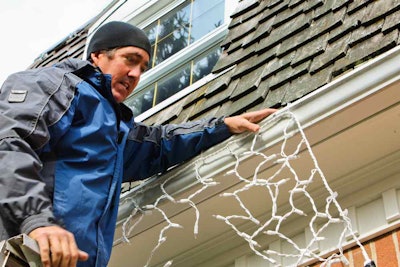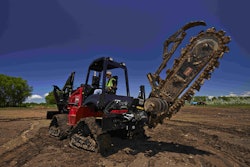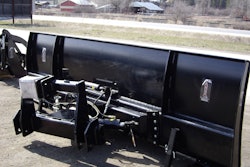 Always practice common sense when working on a ladder. If you can’t reach something, move the ladder instead of overreaching.
Always practice common sense when working on a ladder. If you can’t reach something, move the ladder instead of overreaching.For anyone who has seen “National Lampoon’s Christmas Vacation,” recalling Clark Griswold’s shenanigans on a ladder as he tries to decorate his house is bound to prompt a grin.
However, ladder safety isn’t something to joke about. In fact, it’s still a leading cause of unintentional injury mortality nationwide. In the past decade, 43 percent of fatal falls have involved a ladder, according to the Morbidity and Mortality Weekly Report from the Centers for Disease Control and Prevention.
The three most common causes of ladder accidents are using the wrong ladder, using a ladder in poor condition, or using a ladder improperly.
So here are some tips to pass along to your employees this holiday season, whether they’re stringing lights or pruning trees later on in winter.
Select the right type
It is important to use a ladder that is tall enough that it does not require the user to stand on the top three rungs, whether it’s a straight or extension ladder. The ladder also needs to be able to bear the amount of weight that will be on it. Don’t forget that the total weight is the user and whatever tools are being taken up.
Ladders are typically made of fiberglass, aluminum or wood. Aluminum should not be used around electricity or corrosive or flammable materials. Fiberglass and dry wooden ladders are safe around electricity.
Inspect first
Inspecting a ladder may seem like a waste of time if it was fine the last time you used it, but taking the time to do so could save you from an injury or worse. Ensure there is no slippery or sticky material on the rungs, steps or feet.
Check for cracks, splits, dents, frayed rope and the like, and make sure the spreaders are in working order. Any time a ladder has fallen, been dropped or struck by something, it should be examined for possible damage. Defective or unsafe ladders should be removed from use immediately and labeled as such; they should not be used with a temporary fix.
Use ladders properly
When setting up a ladder, it should be placed 1 foot from the wall for every 4 feet between the base and the support point. Extension ladders need to extend 3 feet beyond the support point.
When climbing a ladder, it is important to have slip-resistant shoes. Also, remember to wipe off any mud or slippery substances from shoe soles. Maintain three points of contact at all times by either keeping two hands and one foot or two feet and one hand on the ladder when climbing.
Keep your body centered on the ladder. Be sure not to lean too far in either direction; if something is out of reach, get down and move the ladder.
Avoid working on a ladder when the weather is windy.
Finally, when placing a ladder on frozen surfaces, ensure the safety feet are deep in the ground. Use a claw hammer to dig 2 to 3 inches deep into the surface and place the feet in the hole. If the ladder is on an unstable surface, secure it either on the top or bottom to prevent displacement.









